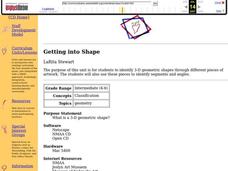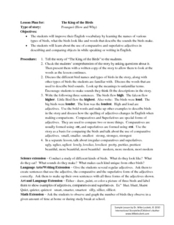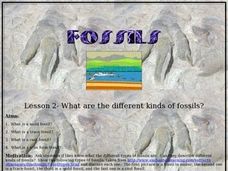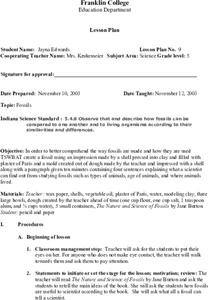Curated OER
Getting into Shape
Young scholars identify 3-D geometric shapes through different pieces of artwork. They examine and identify segments and angles. Students act out shapes and create a piece of artwork. Additional cross curriculum activities are listed.
Curated OER
ADULT ESOL LESSON PLAN--Level 4--Interpersonal Communication
Students examine and practice different types of interpersonal communication. They encounter how to greet people and say good-by in interpreting formal and informal settings (with proper vocabulary).
Core Knowledge Foundation
Weather or Not, Seasons Change
Embark on a year long investigation of the seasons with this 10-lesson earth science unit. After being introduced to different types of weather and the tools used to measure it, young scientists perform fun hands-on activities that...
Curated OER
Rock On!
After five class sessions, young scientists will be able to identify common rock types: igneous, sedimentary, and metamorphic. This plan involves hands-on activities, includes various handouts and worksheets, and requires there to be...
Curated OER
The King of the Birds vocabulary
Science and language skills come together in The King of the Birds. After reading, discuss the names and types of birds in the story and write given sentences to portray the difference between comparative and superlative adjectives....
Curated OER
Oodles of Noodles
Students investigate non-standard and standard measurement including inches and centimeters. They use different types of noodles as non-standard units of measurement comparing them to inches and centimeters.
Curated OER
Rocks and Minerals
First graders examine different types of rocks and minerals. They create models of the rocks and minerals they find interesting. They discuss and explain three ways in which the earth changes.
Curated OER
Genetics 4 Mutations
Students identify and illustrate how changes in DNA cause mutations and evaluate the significance of these changes. They illustrate a chromosomal mutation such as duplication, deletion, inversion, and translocation.
Curated OER
Is This a House for Hermit Crab?
First graders identify text that uses sequence or other logical order. They identify and interpret how different plants and animals inhabit different kinds of environments and have external features that help them thrive in different...
Curated OER
Plasma 101
Learners examine the definitions and characteristics of plasma. After reading an article, they analyze new technologies to study plasma. In groups, they create a poster on how the different types of plasma work and write letters to their...
Curated OER
What are the Different Kinds of Fossils?
Young scholars examine different types of fossils. In this fossil lesson, students investigate the attributes of mold fossils, trace fossils, cast fossils, and true form fossils. Young scholars create their own fossil samples.
Curated OER
The Strength of the Muscular System
Seventh graders investigate the strength of the muscular system. They explore voluntary and involuntary muscle movement and discuss the types of muscles: cardiac or heart, skeletal, and smooth. They visit stations to answer questions...
Curated OER
Johnny Appleseed Reading and Writing
First graders explore language arts by reading a classic story in class. In this word choice lesson, 1st graders read the story of Johnny Appleseed and identify the descriptive words and sentences the author used to entice the reader....
Curated OER
Identifying Clouds
Students work in groups to research and prepare a report on cloud types. They present their findings to the class and take a group quiz competing for points. Students go outside and determine which type of clouds are visible on that day.
Curated OER
Incredible Seeds
Second graders are given a group of seeds and put in small groups. They classify their seeds based on their observations with 90% accuracy. Students draw a picture of each seed showing at least 2 characteristics of each. They write 1...
Curated OER
American Indian Homes in Kansas
First graders explore culture by researching U.S. history. For this American Indian lesson, 1st graders discuss the geography of Kansas and the different Native American tribes that inhabited the state and the types of homes they lived...
Curated OER
Fossils
Fifth graders create a fossil using an impression made with a shell pressed into clay and filled with plaster of Paris and a mold made out of dough and impressed with a shell. They also will receive a paragraph which contains four...
Curated OER
French Cheese
Students discover how cheese in France is made. Using the internet, they read articles about the importance of cheese in the French culture. They identify the various French cheeses and locate the areas in France that manufacture...
Curated OER
B is for Bowling Green
Third graders identify important places in Bowling Green and list facts about those places. They write complete, varied sentences using capitals and punctuation correctly and also use the Writing Process. As a final project, a...
Curated OER
PICKING PEANUTS
Learners create sentences, using words printed on pictures of peanuts. They are explained that the peanut is not really a nut, but a legume, related to beans and peas. Students are also told that the first peanuts grew in Brazil. They...
Curated OER
Good Enough To Eat
Students are introduced to the five food groups. In groups, they place different foods into the correct section of the Food Pyramid. Using different types of technology, they create one page of a class ABC book sharing what they know...
Curated OER
Cloud Discovery
Students create a slideshow that pictorially depicts a variety of cloud types. They research clouds, develop and present the slideshow and then evaluate their efforts based on a rubric for self-evaluation.
Curated OER
Identify That Culture
Students view various types of artwork and try to identify the culture being represented. Using a worksheet, they answer questions based on the artwork and the artist's use of color and technique. They research the artist's country of...
Curated OER
Germs
Third graders dicsuss germ. They discuss how they can't see them (germs), but they're everywhere! Students are asked if germs cause disease? They discuss some types of illnesses they get from germs. Students discuss ways inwhich...























